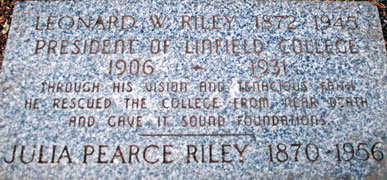-photo by Jordon Jacobo/Review staff writer/photographer
Daniel Clausen
For the Review
While the rumors of ghosts in Northup and Pioneer halls and the Michelbook House deal with restless spirits, at least two bodies rest in peace on campus.
At the northeast corner of Melrose Hall below the president’s office, a handsome but modest granite marker notes the final resting place of Dr. Leonard W. Riley and his wife Julia Pearce Riley. Dr. Riley was president of Linfield from 1906-1931.
While some may find it strange that his remains are buried here, it is really quite fitting. Dr. Riley was responsible for rescuing the college from the brink of closure by taking the presidency in 1906, and made the well-being of Linfield his life’s work. In 1906, the college was in debt and in search of a president.
“Before I see the college close, I will take the job myself,” Dr. Riley said to a fellow member of the presidential search committee. Riley was promptly elected, according to “Linfield’s Hundred Years” by William Frerichs.
Riley’s policies allowed Linfield to survive the first world war and the Depression, emerging as a respected institution.
After retirement in 1931, Dr. Riley moved to Claremont, Calif., where he passed away Jan. 23, 1945. His ashes were sent back to Linfield where they now rest near the foundation of Melrose. Stepping stones, half obscured by rhododendrons, lead to the marker at the cornerstone.
“Through his vision and tenacious faith he rescued the college from near death and gave it sound foundations,” the epitaph, written by Professor Kenneth Scott Latourette, says.
As far as is recorded, these are the only graves on campus.
“I have walked virtually every inch of campus, and I have never noticed another marker,” Professor of Philosophy Marvin Henberg, author of “Inspired Pragmatism: An Illustrated History of Linfield College” and Linfield’s history and trivia expert, said.
Most students are completely oblivious to the gravestone.
“I had no idea that someone was buried in Melrose,” senior Michael Arbogast said.
Even the ever-knowledgeable Dave Hansen, Dean of Students, was long unaware of the marker.
There are no other graves on campus, but there is one memorial. The triangular garden in front of Campbell Hall remembers Steven J. Thomas, alumnus of the class of 1948. He served the college as a landscaper and groundskeeper for many years, and he played an important role in beautifying campus. He won several awards for new varieties of rhododendrons he cultivated, one of which is now in full bloom in his memorial garden.
He died after falling while trimming a maple tree on campus in 1977.
There are countless dedications on campus in the names of buildings and streets, and plaques at the bases of trees or on benches. However, only Mr. and Mrs. Riley have the honor of being buried on the campus they devoted their lives to save.



william i. Elliott • May 14, 2021 at 7:29 pm
Steve Thomas also had an iron grip. He loved to come up behind you and hold you in a half-nelson for about five seconds. I was in Melrose the morning he fell. I walked out briefly to where he had been working. He had already been taken to the hospital. But that particular confined area in that moment took on an eerie silence when one stood still realizing that that is where it happened.
I had before that event visited the country road south of town where Steve’s son died when the VW bug he was driving went off the road and killed him.
amos H • Dec 16, 2009 at 11:55 am
this is good stuff about linfield I like the ghost storeys